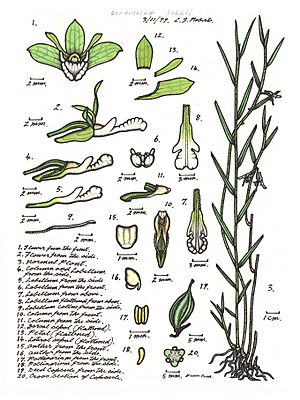Straggly rush orchid facts for kids
Quick facts for kids Straggly rush orchid |
|
|---|---|
 |
|
| Illustration by Lewis Roberts | |
| Scientific classification | |
| Synonyms | |
|
The straggly rush orchid (scientific name: Dendrobium lobbii) is a special kind of plant that belongs to the orchid family. It grows naturally in places from Indochina (parts of Southeast Asia) all the way to northern Australia. This orchid has thin, bendy stems and stiff leaves. Its flowers are usually white or cream-colored. They grow either alone or in pairs where the leaves meet the stem. A part of the flower called the labellum (which is like a lip) is white and often stays partly closed.
Contents
What Does the Straggly Rush Orchid Look Like?
The straggly rush orchid is a plant that grows on the ground. It is a perennial plant, meaning it lives for more than two years. It's also a herb, which means it has soft stems, not woody ones like a tree. This orchid grows in small groups.
Its stems are thin and can be straight or a bit messy, growing about 20 to 60 centimeters (8 to 24 inches) long. The leaves are narrow and shaped like a spear, about 4 to 6 centimeters (1.6 to 2.4 inches) long and 6 millimeters (0.24 inches) wide. The tip of each leaf has a small notch.
Flowers and Their Features
The flowers of the straggly rush orchid are white, cream, or greenish. They are small, about 5 to 10 millimeters (0.2 to 0.4 inches) long and 3 to 5 millimeters (0.12 to 0.2 inches) wide. You'll find them growing one by one or in pairs where the leaves join the stem.
- The sepals (parts that protect the flower bud) are about 4 to 5 millimeters long and 3 millimeters wide.
- The petals (the colorful parts of the flower) are about the same length as the sepals but are thinner.
- The labellum (the special lip-like petal) is white and about 13 millimeters (0.5 inches) long and 5 millimeters (0.2 inches) wide. It has three parts, called lobes. The two side lobes are small and narrow. The middle lobe is shaped like an egg, has a notch, and feels a bit bumpy.
The orchid usually blooms from December to May. Interestingly, its labellum often doesn't open fully. Sometimes, it stays closed completely. This helps the flower to self-pollinate, meaning it can fertilize itself without needing insects or other plants.
How Did It Get Its Name?
The straggly rush orchid, Dendrobium lobbii, was officially described for the first time in 1853. Two scientists, Johannes Elias Teijsmann and Simon Binnendijk, wrote about it. They used a plant sample sent from Singapore. Their description was published in a science journal called Natuurkundig Tijdschrift voor Nederlandsch Indië.
The second part of its scientific name, lobbii, was chosen to honor Thomas Lobb. He was the person who collected the very first plant sample of this orchid that was used for its scientific description.
Where Does It Live?
The straggly rush orchid likes to grow in wet, swampy areas. You can often find it near streams, growing among plants like rushes and sedges (grass-like plants).
This orchid is found in many countries and regions:
- Thailand
- Vietnam
- Borneo
- The Malay Peninsula
- The Philippines
- Sulawesi
- Sumatra
- New Guinea
- The Solomon Islands
It also grows in northern Australia, specifically in areas like Arnhem Land and the Cape York Peninsula. In Australia, it can be found as far south as a town called Cardwell.

